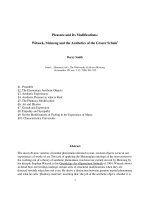Japanese Aesthetics, Wabi-Sabi, and the Tea Ceremony docx
Bạn đang xem bản rút gọn của tài liệu. Xem và tải ngay bản đầy đủ của tài liệu tại đây (21.24 KB, 5 trang )
Japanese Aesthetics, Wabi-Sabi, and the Tea Ceremony
Aesthetics
In the Western world, aesthetics is considered to be the branch of philosophy that is
concerned with concepts of value and beauty as they relate to the arts. Philosophers from
Plato until the present time have had fairly rigid ideas about what artists should create
and what people should like, but in today's world, aestheticians represent a variety of
approaches to the philosophy of art.
Aesthetics, in the broadest sense, may be thought of as a world view, a view that may be
markedly different in other cultures. Objects from other cultures that are categorized as
art works from the Western perspective may or may not hold the same meaning in their
culture of origin. Precisely because of possible differences in world views and aesthetic
stances of non-Western cultures, it is important to set aside Western aesthetics as criteria
when making judgments about non-Western art. For example, many non-Western
cultures recognize no distinction between fine art and craft, may not even have a word for
"art," and may not separate art from everyday life.
Japanese Aesthetics
To understand the art and aesthetics of Japan, it is necessary to investigate a Japanese
world view, ideas about the nature of art, and influences brought about through contact
with other cultures. The aesthetics of Japan developed in a unique fashion, partly because
of its geographic location, a string of islands about 100 miles from Korea and 500 miles
from China. Its isolation by the sea helped protect Japan from foreign invasion and
allowed its rulers to control contact with other nations.
During long periods of self-imposed isolation, art forms and aesthetic ideas developed
which were specifically Japanese. Over the centuries, when interactions with foreign
cultures occurred, they influenced the traditional arts and aesthetics of Japan. For the
purposes of this discussion, the focus will be on what remained essentially Japanese.
Traditional Japanese art and aesthetics were most affected by the Chinese and by
Buddhism, but influences from the West are also evident. For example, the Japanese
made no distinction between fine arts and crafts prior to the introduction of such ideas by
Europeans in the 1870s. The Japanese word that best approximates the meaning of "art"
is katachi. Katachi translates to mean "form and design," implying that art is synonymous
with living, functional purpose, and spiritual simplicity.
The primary aesthetic concept at the heart of traditional Japanese culture is the value of
harmony in all things. The Japanese world view is nature-based and concerned with the
beauty of studied simplicity and harmony with nature. These ideas are still expressed in
every aspect of daily life, despite the many changes brought about by the westernization
of Japanese culture. This Japanese aesthetic of the beauty of simplicity and harmony is
called wabi-sabi (wah-bee sah-bee).
Wabi-Sabi
Since wabi-sabi represents a comprehensive Japanese world view or aesthetic system, it
is difficult to explain precisely in western terms. According to Leonard Koren, wabi-sabi
is the most conspicuous and characteristic feature of what we think of as traditional
Japanese beauty, and it "occupies roughly the same position in the Japanese pantheon of
aesthetic values as do the Greek ideals of beauty and perfection in the West."
Wabi-sabi is a beauty of things imperfect, impermanent, and incomplete.
It is the beauty of things modest and humble.
It is the beauty of things unconventional.
The concepts of wabi-sabi correlate with the concepts of Zen Buddhism, as the first
Japanese involved with wabi-sabi were tea masters, priests, and monks who practiced
Zen. Zen Buddhism originated in India, traveled to China in the 6th century, and was first
introduced in Japan around the 12th century. Zen emphasizes "direct, intuitive insight
into transcendental truth beyond all intellectual conception." At the core of wabi- sabi is
the importance of transcending ways of looking and thinking about things/existence.
All things are impermanent.
All things are imperfect.
All things are incomplete.
Material characteristics of wabi-sabi:
suggestion of natural process
Irregular
Intimate
Unpretentious
Earthy
Simple
As wabi-sabi once was the preeminent high culture Japanese aesthetic, a familiarity with
its concepts is essential for the understanding of the Japanese tea ceremony.
The Japanese Tea Ceremony
"Tea began as a medicine and grew into a beverage." Katkuzo Okakura
"The Way of Tea cannot be taught in any book It is a state of mind. Tea is a living
tradition." Professor Kimiko Gunji, University of Illinois at Urbana-Champaign
"Holding a bowl of tea whisked to a fine froth
Such a simple thing: yet filled with a spirit that
Reaches back more than a thousand years." The Urasenke Tradition of Tea
The most comprehensive example of the Japanese aesthetic of wabi-sabi is found within
the traditions of the tea ceremony. To understand Japanese aesthetics, it is necessary to
understand the unique features of the Japanese tea ceremony, known as chanoyu, chado,
or sado. The tea ceremony is the serving of tea, ritualized over time and rooted in Zen
Buddhism. It symbolizes aesthetic simplicity and represents the fundamental Zen
principles of harmony, respect, purity, and tranquility. The word chanoyu (chah-no-yoo)
literally means "hot water for tea," but its simple art is a synthesis of many Japanese arts
which focus on preparing and serving a bowl of tea.
According to Leonard Koren, the tea ceremony "became an eclectic social art form
combining, among other things, the skills of architecture, interior and garden design,
flower arranging, painting, food preparation, and performance."
The tea ceremony developed under the influence of Zen Buddhism, the aim of which is,
in simple terms, to purify the soul by becoming one with nature. The true spirit of the tea
ceremony has been described by words like calm, rustic, graceful, austere, and simple.
The tea ceremony varies according to the seasons, with tea bowls, types of tea, flowers,
and scrolls appropriately chosen.
The History of the Tea Ceremony
The tea plant probably originated in the mountainous regions of southern Asia and was
later brought to China. Tea was first introduced to Japan along with Buddhism from
China in the 6th century, but the Emperor Shomu, who ruled from 724-749, is credited
with introducing tea drinking into the country after he had been presented bricks of
pressed tea leaves by a Chinese priest. During the Heian period (794-1185), tea was made
from steamed and dried tea leaves ground into a powder. This green tea powder, called
matcha (mah-chah), is still used today.
In the 15th century, Juro Murata, tea master to Shogun Yoshimasa Ashikaga, integrated
many of the concepts of wabi-sabi into the prescribed practices of the tea ceremony,
including the dedication of a special room or house for the sole use in the chanoyu. The
samurai class, familiar with the austerity of Zen Buddhism and the disciplined and
proscribed lifestyle of the warrior, embraced the ceremony of tea. As rules governed
every other aspect of life at the time, participants in tea ceremonies were also required to
follow certain rules and procedures.
An increased emphasis on Zen Buddhist concepts in the tea ceremony was established by
Sen no Rikyu (1522-1591), the most revered Japanese tea master. During the Momoyama
period in the second half of the 16th century, Rikyu established a tea ceremony that
reflects a simple and quiet taste, the form that is practiced and taught in Japan and
throughout the world today. He also designed a simple, separate building to house the
ceremony based on a typical Japanese farmer's rustic hut. Rikyu further formalized the
tea ceremony's rules of behavior and identified the spirit of chanoyu with four basic
Buddhist principles of harmony, respect, purity, and tranquility. These guiding principles
signify the highest ideals of the tea ceremony.
The Seven Rules of Rikyu
"Make a delicious bowl of tea, lay the charcoal so that it heats the water; arrange the
flowers as they are in the field; in summer suggest coolness; in winter, warmth; do
everything ahead of time; prepare for rain; and give those with whom you find yourself
every consideration." Soshitsu Sen
Many stories are told about Rikyu. Rikyu became the tea master for the warlord
Hideyoshi Toyotomi, a difficult and powerful man. Hideyoshi heard of the wonders of
Rikyu's garden of morning glories and expressed a desire to see the flowers. As a result,
Rikyu invited the warlord to tea. When Hideyoshi arrived and walked down the path to
the tea house, not a flower was in sight. Upon entering the tea house, Hideyoshi saw a
single, beautiful morning glory displayed on the alcove. Rikyu had cut down all the other
morning glories so that full attention could be focused on one single blossom.
The power of Japanese warlords is evident in another story about Rikyu. In 1591,
Hideyoshi demanded that Rikyu hand over his daughter to be a concubine to the warlord,
but Rikyu refused. In retaliation, Hideyoshi ordered Rikyu's ritual suicide. Rikyu held a
last tea ceremony at the age of 70 and committed seppuku (ritual suicide) when the
ceremony was completed.
Much of the prescribed behavior used in contemporary tea ceremonies was introduced by
Rikyu. Some of his contributions include a tea house that can accommodate five people, a
separate small room where tea utensils are washed, and two entrances, one for the host
and one for the guests. The entrance for guests had a doorway low enough to require the
guests to bend down to enter, humbling themselves in preparation for the tea ceremony.
In the traditional chanoyu, every part of the ceremony is carefully orchestrated. There are
rituals for entering and leaving the room, making and serving the tea, and appreciating
the choices of flower, scroll, and tea vessel appropriate to the season. The simplicity and
austerity of the tea room (and of Japanese homes) allows a exceptional focus and
appreciation of a single flower or scroll carefully chosen to represent the season.
Aesthetic objects are not left on permanent display in Japanese homes, but are brought
out for focused viewing and appreciation for specific purposes or seasons. As the season
or purpose for display changes, the objects are stored and replaced by others more
appropriate. Though Japanese rooms sometimes may appear too bare or simple for
Western tastes, a Japanese visiting an a typical American home may feel surrounded and
overwhelmed by visual clutter.
by Nancy Walkup for the North Texas Institute for Educators on the Visual Arts
Tea Time Line
(from Important Events in the History of Tea, Birger Nielsen)
708 Tea drinking gains popularity among the Chinese, in part because a hot drink is far
safer than water that may be contaminated, producing intestinal disease if not boiled. Tea
is also valued for its alleged medicinal values.
805 Tea is introduced to Japan as a medicine. The Buddhist bonze (priest) Saicho, spends
three years visiting Chinese Buddhist temples on orders from the emperor, then, returns
to Japan with tea.
1191 Zen Buddhism is introduced into Japan.
1591 Japanese tea master Rikyu commits ritual suicide (seppuku) on orders from
Toyotomi Hideyoshi. Rikyu has formalized the tea ceremony.
1597 The first English mention of tea appears in a translation of a Dutch navigator's
travels. Tea is referred to as chaa.
1657 Public sale of tea begins in London.
Vocabulary
Chado, chanoyu, or sado: Tea ceremony
Soan: Informal tea hut
Suki-ya: Tea house
Mizuya: Tea ceremony preparation room
Shoji: Sliding door to outside
Nijiriguchi: Crawl-through door way
Tatami: Floor mats made of rush
Tokonoma: Alcove
Matcha: Powdered green tea
Natsume: Container for powdered tea
Usucha: Thin tea
Koicha: Thick tea
Kimono: Traditional Japanese clothing
Tabi: Split-toe socks
Resources
Koren, L. (1994). Wabi-Sabi for Artists, Designers, Poets & Philosophers.
Berkeley, California: Stone Bridge Press.
Okakura, K. (1964). The Book of Tea. New York: Dover Publications, Inc.
Sen, S. (1979). Tea Life, Tea Mind. Weatherhill: New York.









